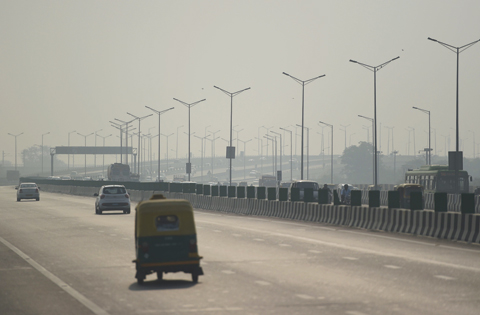Delhi's well-off find ways to keep their kids away from smog
 NEW DELHI: Commuters travel along a highway amidst heavy smog on Monday. — AFP
NEW DELHI: Commuters travel along a highway amidst heavy smog on Monday. — AFPNEW DELHI: Deepa Tampi worries a lot about the air her two children breathe. The garment exporter says she believes her 14-year-old daughter Mahika and 12-year-old son Vihaan both became asthmatic because of high levels of pollution in the New Delhi area. She has banned them from playing outdoors, and has even moved their schools twice in four years so that they can use indoor sports facilities. When there is a toxic haze covering the Indian capital - as has been the case in recent days - she makes sure air purifiers are running at home and in the car, and when the kids do go outside they wear masks.
"Every year, we gasp through the winter months, armed with oral steroids, inhalers and nebulisers," she said. "I have robbed my children of a very simple pleasure in life - being outdoors. Mahika was an athlete and Vihaan loved playing football, but to protect their health, they had to trade these for indoor activities like table tennis and dance." The family paediatrician has suggested they leave the Delhi area because of the kids' asthma, Tampi said, and in the past they have even considered emigrating. But a big change like that is not easy when she is running a business and her husband is a partner at a law firm.
Medical bills
Tampi, who lives in Noda on the outskirts of the city, is in a small minority. She has the knowledge and, more importantly, the money, to reduce the impact of the toxic cocktail of pollution on her kids. That is not the case for most of New Delhi's population of more than 20 million, many of whom are worried about where the next day's work or the next meal is coming from. Ravi Shankar Shukla, 35, who is employed as a chauffeur, says his 8-year-old son, who attends a government school in Noida, complains that his eyes smart and his nose gets blocked when pollution sets in, though he never wears a mask.
Rajesh Kumar, 37, who works as a contract employee with a catering firm, said his two children develop a cough from around mid-October, when the pollution levels rise, until the air quality improves in January. "We run up medical bills during this season," said Kumar, who has a 12-year-old son and a 9-year-old daughter. "The school has given masks, but generally kids don't like wearing them as they feel constricted. Besides, they also fear being ridiculed." Doctors say that many thousands of children are becoming victims of respiratory illnesses in Delhi and its suburbs. More than 10 percent of India's schoolchildren suffer from asthma, according to the federal government.
Pollution levels in the city rose to "severe" last Thursday, a day after revelers let off fireworks long into the night to mark the Hindu festival of Diwali. Two federal government pollution indexes showed air at "very poor" and "severe" levels, indicating that prolonged exposure could lead to respiratory illnesses. North Indian cities, including Delhi, top a list of places with the worst air in the world, the World Health Organization said earlier this year. "I am aware of paediatricians in my hospital doubling or trebling the number of the kids they are seeing with respiratory diseases," said Arvind Kumar, a leading chest surgeon in New Delhi, and the co-founder of the Lung Care Foundation.
The foundation runs Breathe Easy Stay Tough (BEST) clubs in more than 30 schools across Delhi to train students and teachers to build awareness about air pollution, its causes and impact, and to provide tips on how to deal with asthma. Kumar says he hears from principals that most children have some kind of persistent cough these days. "Cough is the first symptom of irritation of your breathing tract. When it becomes more severe, then you start developing narrowing, which manifests as breathlessness and then you need a nebuliser," Kumar said. The federal government launched an asthma manual for schools in 11 languages last month after several incidents, including deaths, blamed on a lack of awareness of the illness.
Mala Kapoor, founder and principal of Silver Line Prestige School in Ghaziabad, on the eastern side of Delhi's national capital region, said roughly 10 percent of her students suffered breathing problems during the winter months. The 3,000-pupil school, established in 1989, jostles for air amidst smoke-spewing small-to-medium-sized factories, new high-rise residential buildings, a busy flyover and a rail track. Kapoor said occasionally students have to be rushed to a nearby hospital if they are having major breathing problems. "This is an example of bad planning," Kapoor said, noting that the school was built before the factories. "I didn't land up in the mess, but the mess was created around me."- Reuters










